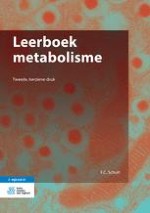Gepubliceerd in:
2015 | OriginalPaper | Hoofdstuk
8. Vetzuur- en cholesterolafgeleiden
Samenvatting
Hoofdstuk 8 bespreekt enkele belangrijke afgeleide moleculen van vetzuren en cholesterol. De metabole verklaring is dat vetzuren en cholesterol aan de basis liggen van vertakte stambomen van synthesereacties. Sommige van deze afgeleide moleculen spelen een rol als signaaloverdragende moleculen. Van vetzuur afgeleide moleculen vinden we in de vorm van triglyceriden (vet in vetcellen), membraanlipiden, maar ook als eicosanoïden. Tot deze laatste groep behoren prostaglandinen en leukotriënen die onder andere een rol spelen bij bloedplaatjesaggregatie en ontstekingsreacties. Belangrijke van cholesterol afgeleide moleculen zijn galzouten, die de vetvertering in de darm ondersteunen, en de steroïdhormonen zoals de bijniersteroïden (cortisol, aldosteron en dehydroepiandrosteron) en de geslachtssteroïden (oestrogenen en testosteron). Ten slotte bespreken we vitamine D, dat in de huid als cholesterolafgeleide ontstaat en via lever en nier tweemaal wordt geoxideerd tot calcitriol, dat een rol speelt in het calciumhuishouding van het lichaam. De vele soorten hydroxyleringsreacties voor de van cholesterol afgeleide moleculen worden gekatalyseerd door leden van de cytochroom p450-familie.
